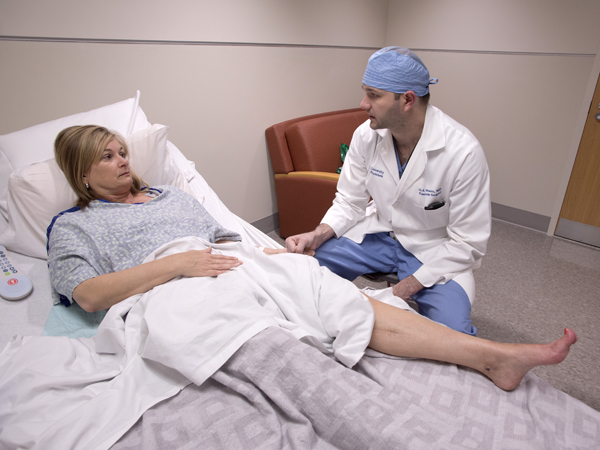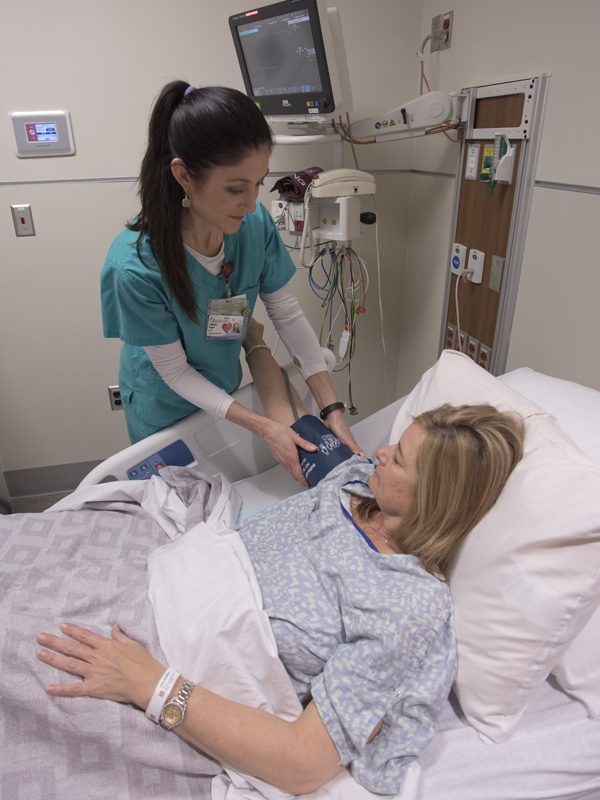UMMC surgeons' goal: limb salvage, not amputation

Jennifer Hall remembers vividly the shock she felt the night a doctor said her painful leg needed to be amputated.
“It started out as a little ache, but one night, my left leg was hurting so badly,” Hall, a Hattiesburg resident, said of her experience in late 2014. “I went to the emergency room, and my leg was turning colors. They called in a surgeon, and he did surgery right then to take a quick look.
“Next thing I know, he told me to consult with my family, and that he would need to take it at the knee or at the ankle. That's when my mother took me to UMMC.”
She was transported by ambulance to the University of Mississippi Medical Center and admitted, Hall said. Dr. Greg Stanley, assistant professor of vascular surgery and a limb salvage specialist, “was waiting on me.” Her condition, she said, appeared to stem from an earlier experience with blood clots below her left knee that ended up damaging an artery.
“We ended up doing surgery first thing in the morning, and he came in and told me he didn't see a need for amputation,” Hall said.
“We throw everything at patients that we have. We are able to save over 90 percent of legs in patients who come here,” said Stanley, a physician in the Medical Center's Division of Vascular Surgery. “We really are saving limbs. There are hundreds of patients who have been told they needed an amputation. To this day, they have their legs.”
Stanley and Dr. John Winscott, associate professor of medicine in the Department of Medicine's Division of Cardiology, have formed a partnership in their quest to salvage the limbs of patients who might otherwise lose them to unnecessary amputation. They act quickly—especially if the patient has developed an infection—and take into account the patient's overall health in a treatment process that often continues over time.
Their patients often need revascularization, or the re-opening of critical arteries to restore blood flow to the endangered limbs. Traditional means of revascularization include vascular bypass, a procedure involving moving a healthy vein from one part of the leg to another in order to redirect blood flow; and angioplasty, a procedure to widen narrow or obstructed arteries by passing a collapsed balloon over a wire into it, then inflating the balloon to force expansion.
“Typically, what we see is that the arteries in the leg are blocked off, either at 100 percent or almost 100 percent,” Stanley said. “The only way the blood can get through is by small collateral vessels. The whole point of bypass surgery is to use a piece of your own vein, or another material, to create a new artery.”

Instead of a standard surgical bypass, which requires an inpatient stay and significant recovery time, the Medical Center's limb restoration team achieves the same result in an outpatient catheterization procedure called atherectomy, Stanley said. “The atherectomy procedure we perform at UMMC literally removes the plaque that is limiting blood flow from the inside out, returning the artery to its normal function. We can accomplish everything we need to through that one small needle stick in the groin, as opposed to an incision,” he said.
“Patients are up walking and on the path to healing that same day,” Stanley said. “We can even re-open arteries in locations that are not traditional locations, all the way down to the ankle and into the foot. Most surgeons would never consider doing that.”
Catheter-based treatment of arterial disease is the common link between Stanley and Winscott, a shared expertise that benefits not just their patients, but those of many Medical Center specialists.
“That's what has led to our success. Our care is patient centered,” Winscott said. “It's a team approach to doing whatever it takes for the patient. We all put egos aside and say, ‘what's best for the patient?’”
Revascularization “is only one piece of the puzzle,” Stanley said. “They need intensive medical care, control of their other co-morbidities, and impeccable wound care.”
That was the case with Lake Village, Ark., retiree Gene Cooper. When poor circulation caused dwindling blood flow to the toes on both his feet, Cooper went to a doctor across the state line in Greenville.

“It started getting bad,” Cooper said of the toes on his left foot. “They had to cut my big toe off, and then the toe next to my big toe. Then the next toe looked bad, too, so I told them to take the whole foot off.”
When the big toe on his right foot worsened, his doctor sent him to UMMC's Wound Care Center. The big toe could not be saved—but doctors were determined to save that foot, and did. “If we're lucky, we get them after they've been told they need a toe amputation for a site that never heals,” Stanley said.
Patients of Stanley and Winscott include those who suffer from peripheral arterial disease, or PAD, a circulatory problem in which narrowed arteries reduce blood flow to the limbs, usually the lower legs and feet. PAD can be a factor in people with uncontrolled diabetes, heart disease, cerebrovascular disease, renal failure, limb trauma, ingrown toenails, poorly healing toe or feet wounds, foot or leg pain with or without activity, or who are overweight. They can require comprehensive care involving multiple specialties.
Like coronary disease, Stanley said, PAD can be a silent killer. The most serious form of PAD, Stanley said, is critical limb ischemia. That's when patients' circulation is so bad that they develop wounds that won't heal, often with burning pain in their lower legs and feet. They also can develop gangrene, a potentially life-threatening condition that happens when body tissue dies.
“The early warning signs are pain in your legs, buttocks, thighs and calves that limit the distance you can walk,” Stanley said. “When it progresses further, you have pain in your feet that wake you up at night, and then wounds spontaneously open on your foot. They can start as a blister that becomes a bigger wound, or result from trauma. They can stub their toe, or get their toenail removed, and it doesn't heal. Once you get to that advanced point, it doesn't take much.”
Often, Stanley said, “patients who are diabetic will see a provider elsewhere and are recommended for an amputation because the site never heals.” And sometimes, just as in Cooper's case, “another toe goes bad and then another toe goes bad.”
When providers tell patients their only option is amputation, “it shows there's a lack of education,” Stanley said. “We offered the same therapy—amputation—2,000 years ago. There's so much we can do to save toes and feet and legs. We are at the cutting edge here.”
Every other week, Winscott said, a group of Medical Center physicians gather for a limb salvage conference. The attendees include Winscott, Stanley, several other vascular surgeons within the division, as well as specialists from areas including plastic surgery and orthopaedics, and Wound Care Center director Dr. Peter Arnold, associate professor of plastic surgery.
“We all present cases and discuss plans for that patient,” Winscott said. “Here, we've been able to develop a very collaborative effort.”
Cooper goes for follow-up care in Greenville. In Hall's case, she's still on a journey to complete recovery.
“My life changed. One minute I was healthy, and then I went to the ER with an aching leg,” said Hall, a mom of three who's gone back to college full time. “But I've seen no other doctor than Dr. Stanley since that day.
“I only had one working artery. I've had to have numerous angiograms,” Hall said. “It's been a long road and we still have a long way, but it's definitely better.”


